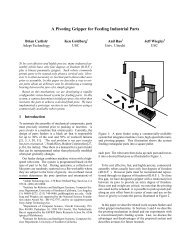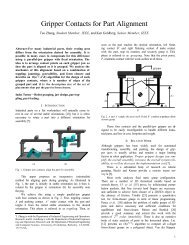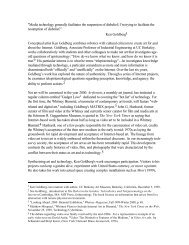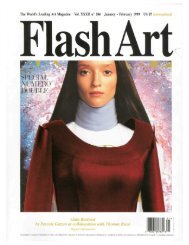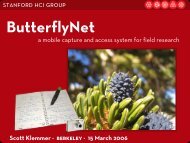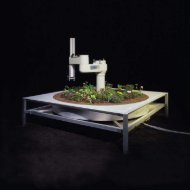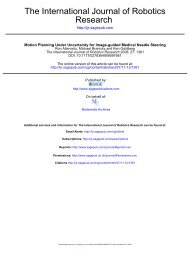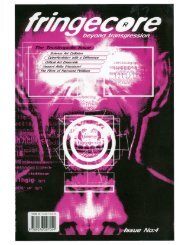“Are We There Yet?” Visual Tracking of Visitors ... - Ken Goldberg
“Are We There Yet?” Visual Tracking of Visitors ... - Ken Goldberg
“Are We There Yet?” Visual Tracking of Visitors ... - Ken Goldberg
You also want an ePaper? Increase the reach of your titles
YUMPU automatically turns print PDFs into web optimized ePapers that Google loves.
<strong>“Are</strong> <strong>We</strong> <strong>There</strong> <strong>Yet</strong>?<strong>”</strong><br />
<strong>Visual</strong> <strong>Tracking</strong> <strong>of</strong> <strong>Visitors</strong> Under<br />
Variable-Lighting Conditions for a Responsive<br />
Audio Art Installation<br />
Andrew B. Godbehere and <strong>Ken</strong> <strong>Goldberg</strong><br />
University <strong>of</strong> California at Berkeley<br />
Abstract. For a responsive audio art installation in a skylit atrium,<br />
we developed a single-camera statistical segmentation and tracking algorithm.<br />
The algorithm combines statistical background image estimation,<br />
per-pixel Bayesian segmentation, and an approximate solution to the<br />
multi-target tracking problem using a bank <strong>of</strong> Kalman filters and Gale-<br />
Shapley matching. A heuristic confidence model enables selective filtering<br />
<strong>of</strong> tracks based on dynamic data. Experiments suggest that our algorithm<br />
improves recall and F2-score over existing methods in OpenCV 2.1. <strong>We</strong><br />
also find that feedback between the tracking and the segmentation systems<br />
improves recall and F2-score. The system operated effectively for<br />
5-8 hours per day for 4 months. Source code and sample data is open<br />
source and available in OpenCV.<br />
Fig. 1. The skylit atrium that was the site for this installation at the Contemporary<br />
Jewish museum in San Francisco, CA from April - July 2011.
2 Are <strong>We</strong> <strong>There</strong> <strong>Yet</strong>?<br />
1 Introduction<br />
1.1 Artistic Overview<br />
The responsive audio art installation <strong>“Are</strong> <strong>We</strong> <strong>There</strong> <strong>Yet</strong>? : 5,000 Years <strong>of</strong> Answering<br />
Questions with Questions<strong>”</strong> was on exhibit at the Yud gallery <strong>of</strong> the<br />
Contemporary Jewish Museum in San Francisco, CA from March 31 – July 31,<br />
2011.<br />
As conceived by <strong>Ken</strong> <strong>Goldberg</strong> & Gil Gershoni, “Questioning is at the core<br />
<strong>of</strong> Jewish cultural and spiritual identity. Jews instinctively question assumptions<br />
and authorities. Jewish mothers teach that ‘it never hurts to ask,’ and a Yiddish<br />
proverb states ‘One who doesn’t ask, doesn’t know.’ Supported by a major<br />
competitive grant from the Creative Work Fund, ’Are <strong>We</strong> <strong>There</strong> <strong>Yet</strong>?’ was a<br />
reactive sound environment where each visit was a unique mix <strong>of</strong> play, poetry,<br />
and contemplation.<strong>”</strong><br />
The installation evoked an early stage in Jewish history when the open desert<br />
created opportunity for revelation; it presented new perspectives on the fundamental<br />
search and questioning that lies at the heart <strong>of</strong> Jewish identity. The Yud<br />
Gallery, designed by Daniel Libeskind and depicted in Figures 1 and 2, acknowledges<br />
the 2nd Commandment, emphasizing the auditory over the visual. For the<br />
installation, speakers were strategically positioned to preserve the open gallery<br />
space. <strong>Visitors</strong> experienced the work as a responsive sequence <strong>of</strong> questions that<br />
encouraged movement throughout the space to explore, discover, and consider.<br />
The project was also inspired by the Talmudic representation <strong>of</strong> multi-layered<br />
Jewish intellectual discourse. The Talmud is a surprisingly contemporary model<br />
for communal conversation in the digital age. Rather than resolving each issue<br />
with an authoritative unified “answer,<strong>”</strong> each page <strong>of</strong> the Talmud reflects the spiraling<br />
layers <strong>of</strong> debate and celebrates the dissent at the heart <strong>of</strong> Jewish thought<br />
and tradition. Open inquiry is fundamental to electronic connectivity and social<br />
networking: the culture <strong>of</strong> new media encourages participation and a natural<br />
skepticism about the authenticity and authority <strong>of</strong> information.<br />
The image in Figure 1 depicts a view <strong>of</strong> the Yud Gallery from its entrance.<br />
Of both artistic and technical interest are the myriad skylights, yielding very<br />
dynamic and atmospheric natural lighting. The illustration in Figure 2 depicts a<br />
schematic <strong>of</strong> the installation design and its spatial configuration, which accompanied<br />
the press release.<br />
Launched in advance <strong>of</strong> the exhibition, the <strong>“Are</strong> <strong>We</strong> <strong>There</strong> <strong>Yet</strong>?<strong>”</strong> companion<br />
website (http://www.are-we-there-yet.org) gave viewers the chance to learn<br />
more about the show, suggest their own questions for inclusion in the exhibition,<br />
and visually explore the suggestions <strong>of</strong> others. In the gallery space, a kiosk with<br />
a custom iPad interface and live, streaming interactive projection system gave<br />
visitors an opportunity to submit their own questions.<br />
<strong>We</strong> developed a state-<strong>of</strong>-the-art computer vision system and a coupled interactive<br />
sound system for the installation. The computer vision system detected<br />
and monitored the position <strong>of</strong> visitors in the space and used that information<br />
to trigger hundreds <strong>of</strong> pre-recorded audio files containing questions spoken by
<strong>“Are</strong> <strong>We</strong> <strong>There</strong> <strong>Yet</strong>?<strong>”</strong> 3<br />
people <strong>of</strong> all ages. A single fixed camera mounted on the ceiling <strong>of</strong> the gallery provided<br />
visual coverage. To address the challenges <strong>of</strong> constantly changing lighting<br />
conditions and the slight background noise produced by the camera, we developed<br />
an adaptive statistical background subtraction algorithm. Outliers (foreground<br />
pixels) in each frame are defined statistically, and grouped together into<br />
connected components (blobs). Our system rejected small blobs while considering<br />
larger blobs candidates for visitors. Dynamic information, based on interframe<br />
consistency (and the notion that visitors don’t move very rapidly) helped<br />
to further reject noise.<br />
1.2 Reviews<br />
A 2-minute video describing the installation is available at<br />
http://j.mp/awty-video-hd, and project reviews and documentation are available<br />
at http://are-we-there-yet.org. Below is a sample <strong>of</strong> press reviews.<br />
– Jonathan Curiel, SF <strong>We</strong>ekly Art Review [43]: “The contemplative<br />
walk is rightfully celebrated as a ritual <strong>of</strong> high importance, and here, at last,<br />
is the perfect museum hybrid: an audio-visual exhibition that asks visitors<br />
thought-provoking questions...getting the words out in midstroll – in a skylit<br />
room designed by Daniel Libeskind, no less – is an exceptional blessing.<strong>”</strong><br />
– David Pescovitz, BoingBoing [44]: “The project pulls a thread dating<br />
back thousands <strong>of</strong> years through Jewish culture and weaves it with innovative<br />
digital technology to create a unique, playful, poetic, and perhaps even<br />
spiritual experience as you wander the room.<strong>”</strong><br />
– Emily Savage, J-<strong>We</strong>ekly Review [48]: “...The walls are white and bare,<br />
and the only sensation is crisp, clear sound... the sensation isn’t like one<br />
you’ve felt before.<strong>”</strong><br />
– Glenn Rosenkrantz, Covenant Foundation [53]: “Take the ages-old<br />
Jewish impulse to question and challenge. Add 21st century technology. And<br />
mix it up a bit with educators emerging embrace <strong>of</strong> new media. The result<br />
is potent.<strong>”</strong><br />
– Molly Samuel, CNN [42]: “A new exhibit at the Contemporary Jewish<br />
Museum in San Francisco doesn’t just challenge visitors. It questions them...<br />
Cameras track each visitor, then a computer uses statistical models to understand<br />
who is where, where they’ve been, and where they’re heading.<strong>”</strong><br />
– Huffington Post [52]: “...Gershoni and <strong>Goldberg</strong> have ingeniously made<br />
the scope as open as possible, anyone with internet access can paticipate,<br />
question, challenge, and create.<strong>”</strong><br />
– Sarah Adler, SF Chronicle [45]: “...Everyone who attends is encouraged<br />
to submit questions to be added to the ever-evolving exhibit. The project is<br />
not about finding answers, but rather about learning how many questions<br />
remain undiscovered.<strong>”</strong><br />
– Stephanie Orma, SF <strong>We</strong>ekly [46]: “Bay Area artists <strong>Ken</strong> <strong>Goldberg</strong> and<br />
Gil Gershoni challenge us to slow down, ask questions, and embrace contemplation.<br />
For they believe that it’s questions – not answers – that help us<br />
understand the past and propel us forward in society and in our lives.<strong>”</strong>
4 Are <strong>We</strong> <strong>There</strong> <strong>Yet</strong>?<br />
– Nirmala Nataraj, SF Chronicle Interview [47]: “...The questions in the<br />
new show range from innocuous to involved, tangential to urgent...<strong>”</strong><br />
– Molly and Seth Samuel, KALW NPR [49] : “...The exhibit is designed<br />
so every visitor hears a different combination <strong>of</strong> questions. the room seems<br />
to know exactly where I am. It feels like the questions are following me as I<br />
walk around.<strong>”</strong><br />
– Carmen Winant, KQED Arts Review [50]: “...it taps into an element<br />
<strong>of</strong> Judaism and Jewishness not <strong>of</strong>ten considered in the public sphere....the<br />
best exhibitions are always the ones that provoke the most questions.<strong>”</strong><br />
– DesignBoom Magazine Review [54]: “The worlds <strong>of</strong> cultural tradition<br />
and technology mediation are brought together in Are <strong>We</strong> <strong>There</strong> <strong>Yet</strong>...<strong>”</strong><br />
– Ryan White, Mill Valley Herald [51]: “...the spirit <strong>of</strong> inquisitiveness<br />
endures longer than the individual questions. Hasn’t compelling art always<br />
been more preoccupied with the asking <strong>of</strong> questions than the disclosure <strong>of</strong><br />
answers?<strong>”</strong><br />
1.3 Technical Overview<br />
In the remainder <strong>of</strong> this chapter, we present the design <strong>of</strong> a computer vision<br />
system that separates video into “foreground<strong>”</strong> and “background<strong>”</strong>, and subsequently<br />
segments and tracks people in the foreground while being robust to<br />
variable lighting conditions. Using video collected during the operation <strong>of</strong> the<br />
installation, under variable illumination created by myriad skylights, we demonstrate<br />
a marked performance improvement over existing methods in OpenCV<br />
2.1. The system runs in real-time (15 frames per second), requires no training<br />
datasets or calibration (unlike feature-based machine learning approaches [38]),<br />
and uses only 2–5 seconds <strong>of</strong> video to initialize.<br />
Our system consists <strong>of</strong> two stages: first is a probabilistic foreground segmentation<br />
algorithm that identifies possible foreground objects using Bayesian<br />
inference with an estimated time-varying background model and an inferred<br />
foreground model, described in Section 2. The background model consists <strong>of</strong><br />
nonparametric distributions on RGB color-space for every pixel in the image.<br />
The estimates are adaptive; newer observations are more heavily weighted than<br />
old observations to accommodate variable illumination. The second portion is<br />
a multi-visitor tracking system, described in Section 3, which refines and selectively<br />
filters the proposed foreground objects. Selective filtering is achieved with<br />
a heuristic confidence model, which incorporates error covariances calculated by<br />
the multi-visitor tracking algorithm. For the tracking subsystem, in Section 3, we<br />
apply a bank <strong>of</strong> Kalman filters [18] and match tracks and observations with the<br />
Gale-Shapley algorithm [13], with preferences related to the Mahalanobis distance<br />
weighted by the estimated error covariance. Finally, a feedback loop from<br />
the tracking subsystem to the segmentation subsystem is introduced: the results<br />
<strong>of</strong> the tracking system selectively update the background image model, avoiding<br />
regions identified as foreground. Figure 3 illustrates a system-level block diagram.<br />
Figure 2 <strong>of</strong>fers an example view from our camera and some visual results<br />
<strong>of</strong> our algorithm.
<strong>“Are</strong> <strong>We</strong> <strong>There</strong> <strong>Yet</strong>?<strong>”</strong> 5<br />
The operating features <strong>of</strong> our system are derived from the unique requirements<br />
<strong>of</strong> an interactive audio installation. False negatives, i.e. people the system<br />
has not detected, are particularly problematic because the visitors expect<br />
a response from the system and become frustrated or disillusioned when the<br />
response doesn’t come. Some tolerance is allowed for false positives, which add<br />
audio tracks to the installation; a few add texture and atmosphere. However,<br />
too many false positives creates cacophony. Performance <strong>of</strong> vision segmentation<br />
algorithms is <strong>of</strong>ten presented in terms <strong>of</strong> precision and recall [30]; many false<br />
negatives corresponds to a system with low recall. Many false positives lowers<br />
precision. <strong>We</strong> discuss precision, recall, and the F2-score in Section 1.7.<br />
Section 4 contains an experimental evaluation <strong>of</strong> the algorithm on video collected<br />
during the 4 months the system operated in the gallery. <strong>We</strong> evaluate<br />
performance with recall and the F2-score [16],[24]. Our results on three distinct<br />
tracking scenarios indicate a significant performance gain over the algorithms in<br />
OpenCV 2.1, when used with the recommended parameters. Further, we demonstrate<br />
that the feedback loop between the segmentation and tracking subsystems<br />
improves performance by further increasing recall and the F2-score.<br />
Fig. 2. Participant Experience: “Entering the Yud Gallery, you encounter soaring walls<br />
and windows carving the space with sunlight. A voice asks: “Can we talk?<strong>”</strong> A pause.<br />
<strong>“Are</strong> you Jewish?<strong>”</strong> You discover that the space is speaking to you. <strong>“Are</strong> you experienced?<strong>”</strong><br />
As you move, the questions become more abstract, “Who is a Jew?<strong>”</strong>, “Is<br />
patience a virtue?<strong>”</strong>, “Is truth a matter <strong>of</strong> perspective?<strong>”</strong> You realize you are creating<br />
your own experience. Questions take on new contexts and meanings as you explore and<br />
consider questions that resonate in new ways.<strong>”</strong> - From the installation description. See<br />
are-we-there-yet.org for more.
6 Are <strong>We</strong> <strong>There</strong> <strong>Yet</strong>?<br />
Quantize<br />
Gale-Shapley<br />
Bayesian<br />
Inference<br />
Morphological<br />
Filtering<br />
Connected<br />
Components<br />
Kalman Filter<br />
Bank<br />
Fig. 3. Algorithm Block Diagram. An image I(k) is quantized in color-space, and compared<br />
against the statistical background image model, ˆ H(k), to generate a posterior<br />
probability image. This image is filtered with morphological operations and then segmented<br />
into a set <strong>of</strong> bounding boxes, M(k), by the connected components algorithm.<br />
The Kalman filter bank maintains a set <strong>of</strong> tracked visitors ˆ Z(k), and has predicted<br />
bounding boxes for time k, ˘ Z(k). The Gale-Shapley matching algorithm pairs elements<br />
<strong>of</strong> M(k) with ˘ Z(k); these pairs are then used to update the Kalman Filter bank. The<br />
result is ˆ Z(k), the collection <strong>of</strong> pixels identified as foreground. This, along with image<br />
I(k), is used to update the background image model to ˆ H(k + 1). This step selectively<br />
updates only the pixels identified as background.<br />
1.4 Related Work<br />
The OpenCV computer vision library [6], [8], [17], [22] <strong>of</strong>fers a variety <strong>of</strong> probabilistic<br />
foreground detectors, including both parametric and nonparametric approaches,<br />
along with several multi-target tracking algorithms, utilizing, for example,<br />
the mean-shift algorithm [10] and particle filters [28]. Another approach<br />
applies the Kalman Filter on any detected connected component, and doesn’t<br />
attempt collision resolution. <strong>We</strong> evaluated these algorithms for possible use in<br />
the installation, although they exhibited low recall, i.e. visitors in the field <strong>of</strong><br />
view <strong>of</strong> the camera were too easily lost, even while moving. This problem arises<br />
from the method by which the background model is updated: every pixel <strong>of</strong><br />
every image is used to update the histogram, so pixels identified as foreground<br />
pixels are used to update the background model. The benefit is that a sudden<br />
change in the appearance <strong>of</strong> the background in a region is correctly identified<br />
as background; the cost is the frequent misidentification <strong>of</strong> pedestrians as background.<br />
To mitigate this problem, our approach uses dynamic information from<br />
the tracking subsystem to filter results <strong>of</strong> the segmentation algorithm, so only<br />
the probability distributions associated with background pixels are updated.<br />
The class <strong>of</strong> algorithm we employ is not the only class available for the<br />
problem <strong>of</strong> detecting and tracking pedestrians in video. A good overview <strong>of</strong> the<br />
various approaches is provided by Yilmaz et al. [40]. Our foreground segmentation<br />
algorithm is derived from a family <strong>of</strong> algorithms which model every pixel
<strong>“Are</strong> <strong>We</strong> <strong>There</strong> <strong>Yet</strong>?<strong>”</strong> 7<br />
<strong>of</strong> the background image with probability distributions, and use these models<br />
to classify pixels as foreground or background. Many <strong>of</strong> these algorithms are<br />
parametric [9], [14], leading to efficient storage and computation. In outdoor<br />
scenes, mixture-<strong>of</strong>-gaussian models capture complexity in the underlying distribution<br />
that single Gaussian distribution models miss [17], [31], [34], [41]. Ours<br />
is nonparametric: it estimates the distribution itself rather than its parameters.<br />
For nonparametric approaches, kernel density estimators are typically used, as<br />
distributions on color-space are very high-dimensional constructs [11]. To efficiently<br />
store distributions for every pixel, we make a sparsity assumption on the<br />
distribution similar to [23], i.e. the random variables are assumed to be restricted<br />
to a small subset <strong>of</strong> the sample space.<br />
Other algorithms use foreground object appearance models, leaving the background<br />
un-modeled. These approaches use support-vector-machines, AdaBoost<br />
[12], or other machine learning approaches in conjunction with a training dataset<br />
to develop classifiers that are used to detect objects <strong>of</strong> interest in images or<br />
videos. For tracking problems, pedestrian detection may take place in each frame<br />
independently [1], [37]. In [29], these detections are fed into a particle-filter multitarget<br />
tracking algorithm. These single-frame detection approaches have been<br />
extended to detecting patterns <strong>of</strong> motion, and Viola et al. [38] show that incorporation<br />
<strong>of</strong> dynamical information into the segmentation algorithm improves<br />
performance. Our algorithm is based on different operating assumptions, notably<br />
requiring very little training data; initialization uses only a couple seconds<br />
<strong>of</strong> video.<br />
A third, relatively new approach, is Robust-PCA [7], which neither models<br />
the foreground nor the background, but assumes that the video sequence I may<br />
be decomposed as I = L + S, where L is low-rank and S is sparse. The relatively<br />
constant background image generates a “low-rank<strong>”</strong> video sequence, and<br />
foreground objects passing through the image plane introduce sparse errors into<br />
the low-rank video sequence. Candès et al. [7] demonstrate the efficacy <strong>of</strong> this<br />
approach for pedestrian segmentation, although the algorithm requires the entire<br />
video sequence to generate the segmentation, so it is not suitable for our<br />
real-time application.<br />
Generally, multi-target tracking approaches attempt to find the precise tracks<br />
that each object follows, to maintain identification <strong>of</strong> each object [4]. For our purposes,<br />
this is unnecessary, and we avoid computationally intensive approaches<br />
like particle-filters [28], [29], [39]. Our sub-optimal approximation <strong>of</strong> the true<br />
maximum likelihood multi-target tracking algorithm allows our system to avoid<br />
exponential complexity [4] and to run in real-time. Similar object-to-track matching<br />
utilizing the Gale-Shapley matching algorithm is explored in [2].<br />
Other authors have pursued applications <strong>of</strong> control algorithms to art [3], [15],<br />
[19], [20], [21], [32], and the emerging applications signal a growing maturity <strong>of</strong><br />
control technology in its ability to coexist with people.
8 Are <strong>We</strong> <strong>There</strong> <strong>Yet</strong>?<br />
1.5 Notation<br />
<strong>We</strong> consider an image sequence <strong>of</strong> length N, denoted {I} N−1<br />
k=0 . The kth image<br />
in the sequence is denoted I(k) ∈ Cw×h , where w and h are the image width<br />
and height in pixels, respectively, and C = {(c1, c2, c3) : 0 ≤ ci ≤ q − 1} is the<br />
color-space for a 3-channel video. For our 8-bit video, q = 256, but quantization<br />
described in Section 2.1 will alter q. <strong>We</strong> downsample the image by a factor <strong>of</strong> 4<br />
and use linear interpolation before processing, so w and h are assumed to refer<br />
to the size <strong>of</strong> the downsampled image.<br />
Denote the pixel in column j and row i <strong>of</strong> the kth image <strong>of</strong> the sequence as<br />
Iij(k) ∈ C. Denote the set <strong>of</strong> possible subscripts as I ≡ {(i, j) : 0 ≤ i < h, 0 ≤<br />
j < w}, referred to as the “index set<strong>”</strong>, and (0, 0) is the upper-left corner <strong>of</strong> the<br />
image plane. For this paper, if A ⊂ I, let Ac ⊂ I and A Ac = I. Define an<br />
inequality relationship for tuples (x, y) as (x, y) ≤ (u, v) if and only if x ≤ u and<br />
y ≤ v.<br />
The color <strong>of</strong> each pixel is represented by a random variable, Iij(k) ∼ Hij(k),<br />
where Hij(k) : C → [0, 1] is a probability mass function. Using a “lifting<strong>”</strong> operation<br />
L, map each element c ∈ C to unique axes <strong>of</strong> Rq3 with value [Hij(k)](c)<br />
to represent probability mass functions as vectors (or normalized histograms),<br />
a convenient representation for the rest <strong>of</strong> the paper. Note that 1T Hij(k) = 1,<br />
when conceived <strong>of</strong> as a vector; 1 ∈ Rq3. Denote an estimated distribution as<br />
ˆHij(k). Let ˆ H(k) = { ˆ Hij(k) : (i, j) ∈ I} represent the background image model,<br />
as in Figure 3.<br />
A foreground object is defined as an 8-connected collection <strong>of</strong> pixels in the<br />
image plane corresponding to a visitor. Define the set <strong>of</strong> foreground objects at<br />
time k as X(k) = {χn ⊂ I : n < R(k)}, where χn represents an 8-connected<br />
collection <strong>of</strong> pixels in the image plane, and R(k) represents the number <strong>of</strong><br />
foreground objects at time k. Let F (k) = <br />
χ∈X(k) χ be the set <strong>of</strong> all pixels<br />
in the image associated with the foreground. <strong>We</strong> define the minimum bounding<br />
box around each contiguous region <strong>of</strong> pixels with the upper left and lower<br />
right corners: let x + n = arg min (i,j)∈I(i, j) s.t. (i, j) ≥ (u, v) ∀(u, v) ∈ χn, and<br />
x− n = arg max (i,j)∈I(i, j) s.t. (i, j) ≤ (u, v) ∀(u, v) ∈ χn. The set <strong>of</strong> pixels within<br />
the minimum bounding box <strong>of</strong> χn is ¯χn = {(i, j) : x− n ≤ (i, j) ≤ x + n }. Then, let<br />
F (k) = <br />
n
1.6 Assumptions<br />
With this notation, we make the following assumptions:<br />
<strong>“Are</strong> <strong>We</strong> <strong>There</strong> <strong>Yet</strong>?<strong>”</strong> 9<br />
1. Foreground regions <strong>of</strong> images are small.<br />
In general, there are relatively few visitors and this assumption holds. In<br />
some anomalous circumstances, this assumption may be violated, during<br />
galas and special events. <strong>We</strong> implemented a failsafe in these circumstances<br />
to allow the system to re-initialize and recover.<br />
Let B(k) ≡ F (k) c represent the set <strong>of</strong> pixels associated with the background.<br />
Assume that |B(k)| ≫ |F (k)|.<br />
2. The color distribution <strong>of</strong> a given pixel changes slowly relative to the frame<br />
rate. The appearance is allowed to change rapidly, as with a flickering light,<br />
but the distribution <strong>of</strong> colors at a given pixel must remain essentially constant<br />
between frames. In practice, this condition is only violated in extreme<br />
situations, as when lights are turned on or <strong>of</strong>f. High-level logic helps the<br />
algorithm recover from a violation <strong>of</strong> this assumption.<br />
Interpreting Hij(k) as a vector, ∃ɛ > 0 such that for all i, j, k,<br />
||Hij(k) − Hij(k + 1)|| < ɛ, where ɛ is small.<br />
3. To limit memory requirements, we store only a small number <strong>of</strong> the total<br />
possible histogram bins. To avoid a loss <strong>of</strong> accuracy, we make an assumption<br />
that most elements <strong>of</strong> Hij(k) are 0. In other words, each pixel can only take<br />
on a few colors relative to the total number <strong>of</strong> possible colors.<br />
The support <strong>of</strong> the probability mass function Hij(k) is sparse over C.<br />
4. By starting the algorithm before visitors enter the gallery, we assume that<br />
the image sequence contains no visitors for the first few seconds.<br />
∃K > 0 such that R(k) = 0 ∀k < K.<br />
5. Pixels corresponding to visitors have a color distribution distinct from the<br />
background distribution.<br />
Consider a foreground pixel Iij(k) such that (i, j) ∈ F (k), has probability<br />
mass function Fij(k). The background distribution at the same pixel is<br />
Hij(k). Interpreting distributions as vectors, ||Fij(k)−Hij(k)|| > δ for some<br />
δ > 0. While this property is necessary in order to detect a visitor, it is not<br />
sufficient, and we use additional information for classification.<br />
6. <strong>Visitors</strong> move slowly in the image plane relative to the camera’s frame-rate.<br />
Formally, assuming χi(k) and χi(k + 1) refer to the same foreground object<br />
at different times, there is a significant overlap between χi(k) and χi(k + 1):<br />
|χi(k)∩χi(k+1)|<br />
|χi(k)∪χi(k+1)| > O, O ∈ (0, 1), where O is close to 1.<br />
7. <strong>Visitors</strong> move according to a straight-line motion model with Gaussian process<br />
noise in the image plane.<br />
Such a model is used in pedestrian tracking [25] and is used in tracking the<br />
location <strong>of</strong> mobile wireless devices [27]. Further, the model can be interpreted<br />
as a rigid body traveling according to Newton’s laws <strong>of</strong> motion. <strong>We</strong> also<br />
assume that the time between each frame is approximately constant, so the<br />
Kalman filter system matrices <strong>of</strong> Section 3 are constant.
10 Are <strong>We</strong> <strong>There</strong> <strong>Yet</strong>?<br />
1.7 Problem Statement<br />
Performance <strong>of</strong> each algorithm is measured as a function <strong>of</strong> the number <strong>of</strong> pixels<br />
correctly or incorrectly identified as belonging to the foreground bounding box<br />
support, F (k). First, tp refers to the number <strong>of</strong> pixels the algorithm correctly<br />
identifies as foreground pixels: tp(k) = |F (k) ˆ Z(k)|. fp is the number <strong>of</strong> pixels<br />
incorrectly identified as foreground pixels: fp(k) = |F (k) c ˆ Z(k)|. Finally, fn<br />
is the number <strong>of</strong> pixels identified as background that are actually foreground<br />
pixels: fn(k) = |F (k) ˆ Z(k) c |. As in [30], define “precision<strong>”</strong> as p = tp<br />
tp+fp and<br />
“recall<strong>”</strong> as r = tp<br />
tp+fn<br />
. For our interactive installation, recall is more important<br />
than precision, so we use the F2-score [16],[24], a weighted harmonic mean that<br />
puts more emphasis on recall than precision:<br />
F2 = 5pr<br />
4p + r<br />
The problem is then: for each image I(k) in sequence {I} N−1<br />
k=0 , find a collection<br />
<strong>of</strong> foreground pixels ˆ Z(k) such that F2(k) is maximized. The optimal value<br />
at each time is 1, which corresponds to an algorithm returning precisely the<br />
bounding boxes <strong>of</strong> the true foreground objects: ˆ Z(k) = F (k). <strong>We</strong> use Equation<br />
1 to evaluate our algorithm in Section 4.<br />
2 Probabilistic Foreground Segmentation<br />
In this section, we focus on the top row <strong>of</strong> Figure 3, which takes an image I(k)<br />
and generates a set <strong>of</strong> bounding boxes <strong>of</strong> possible foreground objects, denoted<br />
M(k). ˆ Z(k), the final estimated collection <strong>of</strong> foreground pixels, is used with I(k)<br />
to update the probabilistic background model for time k + 1.<br />
2.1 Quantization<br />
<strong>We</strong> store a histogram ˆ Hij(k) on RGB color-space for every pixel. ˆ Hij(k) must<br />
be sparse by Assumption 3, so the number <strong>of</strong> exhibited colors is limited to<br />
Fmax, a system parameter. Noise in the camera’s electronics, however, spreads<br />
the support <strong>of</strong> the underlying distribution, threatening the sparsity assumption.<br />
To mitigate this effect, we quantize the color-space. <strong>We</strong> perform a linear<br />
quantization, given parameter q < 256, and interpreting Iij(k) ∈ C as a vector,<br />
Îij(k) = ⌊ q<br />
256Iij(k)⌋. The floor operation reflects the typecast to integer in s<strong>of</strong>tware<br />
in each color channel. Note that this changes the color-space C by altering<br />
q as indicated in Section 1.5.<br />
2.2 Histogram Initialization<br />
<strong>We</strong> use the first T frames <strong>of</strong> video as training data to initialize each pixel’s<br />
estimated probability mass function, or background model. Interpret the probability<br />
mass function ˆ Hij(k) as a vector in Rq3, where each axis represents a<br />
(1)
<strong>“Are</strong> <strong>We</strong> <strong>There</strong> <strong>Yet</strong>?<strong>”</strong> 11<br />
Fig. 4. Probabilistic Foreground Segmentation and <strong>Tracking</strong> Pipeline. Upper Left: Raw<br />
image. Lower Left: Posterior probability image. Lower Right: Filtered and thresholded<br />
posterior image. Upper right: Bounding boxes <strong>of</strong> tracked foreground objects and annotated<br />
confidence levels.<br />
unique color. <strong>We</strong> define a lifting operation L : C → F ⊂ Rq3 by generating<br />
a unit vector on the axis corresponding to the input color. The set F is the<br />
“feature set,<strong>”</strong> representing all unit vectors in Rq3. Let fij(k) = L( Îij(k)) ∈ F be<br />
a feature (pixel color) observed at time k. Of the T observed features, select the<br />
Ftot ≤ Fmax most recently observed unique features; let I ⊂ {1, 2, . . . T }, where<br />
|I| = Ftot, be the corresponding time index set. (If T > Fmax, it is possible that<br />
Ftot, the number <strong>of</strong> distinct features observed, exceeds the limit Fmax. In that<br />
case, we throw away the oldest observations so Ftot ≤ Fmax.) Then, we calculate<br />
an average to generate the initial histogram: ˆ Hij(T ) = 1 <br />
Ftot r∈I fij(r). This<br />
puts equal weight, 1/Ftot, in Ftot unique bins <strong>of</strong> the histogram.<br />
2.3 Bayesian Inference<br />
<strong>We</strong> use Bayes’ Rule to calculate the likelihood <strong>of</strong> a pixel being classified as<br />
foreground (F) or background (B) given the observed feature, fij(k). To simplify<br />
notation, let p(F |f) represent the probability that pixel (i, j) is classified as<br />
foreground at time k given feature fij(k). Using Bayes’ rule and the law <strong>of</strong> total<br />
probability,
12 Are <strong>We</strong> <strong>There</strong> <strong>Yet</strong>?<br />
Featuref<br />
Bayes’<br />
Rule<br />
p(B|f) =<br />
p(F |f) = 1 − p(B|f)<br />
Background Model (B)<br />
p(f|B)p(B)<br />
p(f|B)p(B) + p(f|F )p(F )<br />
[0.0,1.0]<br />
p(f|B)<br />
Posterior<br />
Probability<br />
Fig. 5. Probabilistic Foreground Segmentation System Block Diagram for a single<br />
pixel. Feature is the observed RGB color. Its observed likelihood is referenced from<br />
the existing empirical probability distribution on color-space for the pixel. Bayes’ rule<br />
enables us to calculate the probability that the pixel is part <strong>of</strong> the foreground.<br />
p(B|f) =<br />
p(f|B)p(B)<br />
p(f|B)p(B) + p(f|F )p(F )<br />
<strong>We</strong> calculate p(f|B) = fij(k) T ˆ Hij(k), as ˆ Hij(k) represents the background<br />
model. The prior probability that a pixel is foreground is a constant parameter,<br />
p(F ), a design parameter that affects the sensitivity <strong>of</strong> the segmentation algorithm.<br />
As there are only two labels, p(B) = 1−p(F ). Without a statistical model<br />
for the foreground, however, we cannot calculate Bayes’ rule explicitly. Making<br />
use <strong>of</strong> Assumption 5, we let p(f|F ) = 1 − p(f|B), which has the nice property<br />
that if p(f|B) = 1, then the pixel is certainly identified as background, and if<br />
p(f|B) = 0, the pixel is certainly identified as foreground. After calculating posterior<br />
probabilities for every pixel, the posterior image is P (k) ∈ [0, 1] w×h where<br />
Pij(k) = p(F |fij(k)) = 1 − p(B|fij(k)).<br />
2.4 Filtering and Connected Components<br />
Given the posterior image, P (k), we perform several filtering operations to prepare<br />
a binary image for input to the connected components algorithm. <strong>We</strong> perform<br />
a morphological open followed by a morphological close on the posterior<br />
image with a circular kernel <strong>of</strong> radius r, a design parameter, using the notion <strong>of</strong><br />
morphological operations on greyscale images discussed in [35],[36]. Such morphological<br />
operations have been used previously in segmentation tasks [26]. Intuitively,<br />
the morphological open operation will reduce the estimated probability<br />
(2)
<strong>“Are</strong> <strong>We</strong> <strong>There</strong> <strong>Yet</strong>?<strong>”</strong> 13<br />
<strong>of</strong> pixels that aren’t surrounded by a region <strong>of</strong> high-probability pixels, smoothing<br />
out anomalies. The close operation increases the probability <strong>of</strong> pixels that are<br />
close to regions <strong>of</strong> high-probability pixels. The two filters together form a sort<br />
<strong>of</strong> smoothing operation, yielding a modified probability image ˘ P (k).<br />
<strong>We</strong> apply a threshold with level γ ∈ (0, 1) to ˘ P (k) to generate a binary image<br />
P(k). This threshold acts as a decision rule: if ˘ Pij(k) ≥ γ, Pij(k) = 1, and<br />
otherwise, Pij(k) = 0, where 1 corresponds to “foreground<strong>”</strong> and 0 to “background<strong>”</strong>.<br />
Then, we perform morphological open and close operations on Pij(k);<br />
operating on a binary image, these morphological operations have their standard<br />
definition. The morphological open operation will remove any foreground region<br />
smaller than the circular kernel <strong>of</strong> radius r ′ , a design parameter. The morphological<br />
close operation fills in any region too small for the kernel to fit without<br />
overlapping an existing foreground region, connecting adjacent regions.<br />
On the resulting image, the connected components algorithm detects 8connected<br />
regions <strong>of</strong> pixels labeled as foreground. For this calculation, we make<br />
use <strong>of</strong> OpenCV’s findContours() function [5] which returns both contours <strong>of</strong> connected<br />
components, used in Section 3.2, and the set <strong>of</strong> bounding boxes around<br />
the connected components, denoted M(k). These bounding boxes are used by<br />
the tracking system in Section 3, so we represent them as vectors: for m ∈ M(k),<br />
m ∈ R 4 with axes representing the x, y coordinates <strong>of</strong> the center, along with the<br />
width and height <strong>of</strong> the box.<br />
2.5 Updating the Histogram<br />
The tracking algorithm takes M(k), the list <strong>of</strong> detected foreground objects, as<br />
input and returns ˆ Z(k), the set <strong>of</strong> pixels identified as foreground. To update the<br />
histogram, we make use <strong>of</strong> feature fij(k), defined in Section 2.2.<br />
First, the histogram Hij(k) is not updated if it corresponds to a foreground<br />
pixel: if (i, j) ∈ ˆ Z(k), then Hij(k + 1) = Hij(k).<br />
Otherwise, let S represent the support <strong>of</strong> the histogram Hij(k), or the set <strong>of</strong><br />
non-zero bins: S = {x ∈ F : x T Hij(k) = 0} ⊂ F. By the sparsity constraint,<br />
|S| ≤ Fmax. If feature fij(k) has no weight in the histogram (fij(k) T Hij(k) = 0)<br />
and there are too many features in the histogram (|S| = Fmax), a feature must<br />
be removed from the histogram before updating to maintain the sparsity constraint.<br />
The feature with minimum weight (one arbitrarily selected in event <strong>of</strong><br />
a tie) is removed and the histogram is re-normalized. Selecting the minimum:<br />
f ∈ arg minx∈S x T Hij(k). Removing f and re-normalizing:<br />
ˆHij(k) = Hij(k) − f T Hij(k)f<br />
1 − f T Hij(k)<br />
Finally, we update the histogram with the new feature:<br />
(3)<br />
Hij(k + 1) = (1 − α) ˆ Hij(k) + αfij(k) (4)<br />
The parameter α affects the adaptation rate <strong>of</strong> the histogram. Given that a<br />
particular feature f ∈ F was last observed τ frames in the past and had weight
14 Are <strong>We</strong> <strong>There</strong> <strong>Yet</strong>?<br />
ω, the feature will have weight ω(1 − α) τ . As α gets larger, the past observations<br />
are “forgotten<strong>”</strong> more quickly. This is useful for scenes in which the background<br />
may change slowly, as with natural lighting through the course <strong>of</strong> a day.<br />
3 Multiple Visitor <strong>Tracking</strong><br />
Lacking camera calibration, we track foreground visitors in the image plane<br />
rather than the ground plane. Once the foreground/background segmentation<br />
algorithm returns a set <strong>of</strong> detected visitors, the challenge is to track the visitors<br />
to gather useful state information: their position, velocity, and size in the image<br />
plane.<br />
Using Assumption 7, we approximate the stochastic dynamical model <strong>of</strong> a<br />
visitor as follows: zi(k + 1) = Azi(k) + qi(k), mi(k) = Czi(k) + ri(k), qi(k) ∼<br />
N (0, Q), ri(k) ∼ N (0, R), R = σI,<br />
⎡<br />
A = ⎣ A′ 0 0<br />
0 A ′ ⎤<br />
0 ⎦ , A<br />
0 0 I2<br />
′ <br />
1 1<br />
=<br />
0 1<br />
⎡ ⎤<br />
1 0 0 0 0 0 ⎡ ⎤<br />
Qx ⎢<br />
C = ⎢0<br />
0 1 0 0 0⎥<br />
0 0<br />
⎥<br />
⎣0<br />
0 0 0 1 0⎦<br />
, Q = ⎣ 0 Qy 0 ⎦<br />
0 0 Qs<br />
0 0 0 0 0 1<br />
where I2 is a 2-dimensional identity matrix. State vector zi(k) ∈ R 6 encodes<br />
the x-position, x-velocity, y-position, y-velocity, width, and height <strong>of</strong> the bounding<br />
box respectively, relative to the center <strong>of</strong> the box. mi(k) ∈ R 4 represents the<br />
observed bounding box <strong>of</strong> the object. Q, R ≻ 0 are the covariances, parameters<br />
for the algorithm. Let Z(k) = {zi(k) : i < Z(k)} be the true states <strong>of</strong> the Z(k)<br />
visitors. Let ˆ Z(k) = {ˆzi(k) : i < ˆ Z(k)} be the set <strong>of</strong> ˆ Z(k) estimated states. Let<br />
˘Z(k) = {˘zi(k) : i < ˘ Z(k)} be the set <strong>of</strong> ˘ Z(k) predicted states. M(k) is the set <strong>of</strong><br />
observed bounding boxes at time k, and ˘ M(k) = { ˘mi : ˘mi = C ˘zi(k), i < ˘ Z(k)}<br />
is the set <strong>of</strong> predicted observations.<br />
Given this linear model, and given that observations are correctly matched<br />
to the tracks, a Kalman filter bank solves the multiple target tracking problem.<br />
In Section 3.1, we discuss the matching problem. When observations are not<br />
matched with an existing track, a new track must be created in the Kalman<br />
filter bank. Given an observation m ∈ R 4 , representing a bounding box, we<br />
initialize a new Kalman filter with state z = (C T C) −1 C T m, the pseudo-inverse<br />
<strong>of</strong> m = Cz, and initial error covariance P = C T RC+Q. In Section 3.2, we discuss<br />
criteria for tracks to be deleted. After matching and deleting low confidence<br />
tracks, the tracking algorithm has a set <strong>of</strong> estimated bounding boxes, ˆ M(k) =<br />
{ ˆmn = C ˆzn(k) : n < ˆ Z(k)}. The final result must be a set <strong>of</strong> pixels identified as<br />
foreground, ˆ Z(k) ⊂ I, and we need to convert mi from vector form to coordinates<br />
<strong>of</strong> the corners <strong>of</strong> the bounding box to generate ˆ Z(k), which is used to evaluate<br />
performance at time k in Section 4. Using superscripts to denote elements <strong>of</strong> a
<strong>“Are</strong> <strong>We</strong> <strong>There</strong> <strong>Yet</strong>?<strong>”</strong> 15<br />
vector, m 1 n and m 2 n are the x and y coordinates <strong>of</strong> the center <strong>of</strong> the box. m 3 n<br />
and m 4 n are the width and height. To convert the vector back to a subset <strong>of</strong> I,<br />
let m− n = (m1 n − m3n<br />
2 , m2n − m4n<br />
2 ) ∈ I and m+ n = (m1 n + m3n<br />
2 , m2n + m4n<br />
2 ) ∈ I. If<br />
any coordinate lies outside the limits <strong>of</strong> I, we set that coordinate to the closest<br />
value within I, to clip to the image plane. Let νn = {(i, j) : m− n ≤ (i, j) ≤ m + n }.<br />
Finally, ˆ Z(k) = <br />
n< ˆ Z(k) νn ⊂ I, the set <strong>of</strong> pixels within the estimated bounding<br />
boxes.<br />
3.1 Gale-Shapley Matching<br />
Matching observations to tracks makes multiple-target tracking a difficult problem:<br />
in its full generality, the problem requires re-computation <strong>of</strong> the Kalman<br />
filter over the entire time history as previously decided matchings may be rejected<br />
with the additional information, preventing recursive solutions. To avoid<br />
this complexity, sub-optimal solutions are sought. In this section, we describe<br />
a greedy, recursive approach that, for a single frame, matches observations to<br />
tracks to update the Kalman filter bank.<br />
While some algorithms, e.g. mean-shift [10], use information gathered about<br />
the appearance <strong>of</strong> the foreground object to aid in track matching, our algorithm<br />
does not: we assume that individuals are indistinguishable. Here, observationto-track<br />
matching is performed entirely within the context <strong>of</strong> the probability<br />
distribution induced by the Kalman filters. <strong>We</strong> make use <strong>of</strong> the Gale-Shapley<br />
matching algorithm [13], the solution to the “stable-marriage<strong>”</strong> problem.<br />
In what follows, we describe the matching problem at time k. Formally, we<br />
are given M, the set <strong>of</strong> detected foreground object bounding boxes, and ˘ Z,<br />
the set <strong>of</strong> predicted states. Let |M| = M and | ˘ Z| = Z. Introduce placeholder<br />
sets M ∅ and Z ∅ such that |M ∅| = Z and |Z ∅| = M. Further, M M ∅ = ∅<br />
and ˘ Z Z ∅ = ∅. These placeholder sets will allow tracks and observations to<br />
be unpaired, implying a continuation <strong>of</strong> a track with a missed observation [33],<br />
or the creation <strong>of</strong> a new track. Define extended sets as M + = M M ∅ and<br />
Z + = ˘ Z Z ∅. Note that |M + | = |Z + |, a prerequisite for applying the Gale-<br />
Shapley algorithm [13]. Let G ≡ |M + |.<br />
<strong>We</strong> now describe the preference relation necessary for the Gale-Shapley algorithm.<br />
Let mi ∈ M and ˘zj ∈ ˘ Z. ˘zj is the predicted state <strong>of</strong> track j. The<br />
Kalman filter estimates an error covariance for the predicted state: Pj ≻ 0. <strong>We</strong><br />
are interested in comparing observations, not states, so the estimated error covariance<br />
<strong>of</strong> the predicted observation, ˘mj = C ˘zj, is CPjC T + R, from the linear<br />
system described at the start <strong>of</strong> Section 3. The Mahalanobis distance between<br />
two observations under this error covariance matrix is<br />
<br />
d(mi, ˘mj) =<br />
(mi − ˘mj) T (CPjC T + R) −1 (mi − ˘mj) (5)<br />
To make a preference relation, we exponentially weight the distance: ωij =<br />
exp(−d(mi, ˘mj)), ωij ∈ (0, 1). As the distance approaches 0, ωij → 1. Making<br />
use <strong>of</strong> Assumption 6, we place constraints on the distance: for some threshold
16 Are <strong>We</strong> <strong>There</strong> <strong>Yet</strong>?<br />
γmin ∈ (0, 1), if ωij < γmin (equiv. the distance is too great), then we deem<br />
the matching impossible, by Assumption 6. The symmetric preference relation<br />
φ : M + × Z + → R is as follows:<br />
⎧<br />
⎪⎨ 0 mi ∈ M∅ or ˘zj ∈ Z∅ φ(mi, ˘zj) = ωij<br />
⎪⎩<br />
−1<br />
ωij ≥ γmin<br />
ωij < γmin<br />
(6)<br />
Equation 6 indicates that if a track ˘zj or observation mi is to be unpaired,<br />
the preference relation between ˘zj and mi is 0. If the Mahalanobis distance<br />
is too large, the preference relation is −1, so not pairing the two is preferred.<br />
Otherwise, the preference is precisely the exponentially weighted Mahalanobis<br />
distance between the predicted observation ˘mj and mi.<br />
Then, the Gale-Shapley algorithm with Z + as the proposing set pairs each<br />
z ∈ Z + with exactly one m ∈ M + , resulting in a stable matching. That is, if<br />
observation i is paired with track j, and another observation n is paired with<br />
track k, if ωij < ωik, then ωik < ωnk, so while observation i would benefit from<br />
matching with track k, track k would lose, so no re-matching is accepted. Gale<br />
and Shapley prove that their algorithm generates a stable matching, and that<br />
it is optimal for Z + in the sense that, if wj is the final score associated with<br />
zj ∈ Z + after matching, then <br />
j ωj is maximized over the set <strong>of</strong> all possible<br />
stable matchings [13]. Thus, tracks are paired with the best possible candidate<br />
observations.<br />
<strong>We</strong> refer to the final matching as the set M ⊂ Z + ×M + , where |M| = G. M is<br />
the input to the Kalman Filter bank as in Figure 3. Then, each pair (z, m) ∈ M<br />
is used to update the Kalman filter bank: depending on the pairing, this creates<br />
a new track, or updates an existing track with or without an observation. The<br />
Kalman update step generates ˆ Z(k) and ˘ Z(k +1). ˆ Z(k) is used to generate ˆ M(k)<br />
and ˆ Z(k) as described at the beginning <strong>of</strong> Section 3, and ˘ Z(k + 1) is used as<br />
input for the next iteration <strong>of</strong> the Gale-Shapley Matching algorithm.<br />
3.2 Heuristic Confidence Model<br />
<strong>We</strong> employ a heuristic confidence model to discern people from spurious detections<br />
such as reflections from skylights. <strong>We</strong> maintain a confidence level ci ∈ [0, 1]<br />
for each tracked object zi ∈ ˆ Z(k), which is a weighted mix <strong>of</strong> information from<br />
the error covariance <strong>of</strong> the Kalman filter, the size <strong>of</strong> the object, and the amount<br />
<strong>of</strong> shape deformation <strong>of</strong> the contour <strong>of</strong> the object (provided by OpenCV). Typically,<br />
undesirable objects are small, move slowly, and have a nearly constant<br />
contour.<br />
In the following, we drop the dependence on time k for simplicity and denote<br />
time k + 1, with a superscript +.<br />
Consider an estimated state ˆz ∈ ˆ Z, with error covariance P . Let c dyn =<br />
exp(− det(P )/γdet), with parameter γdet. Intuitively, as the determinant <strong>of</strong> P<br />
increases, the region around ˆz which is likely to contain the true state expands,<br />
implying lower confidence in the estimate. Let c sz = 1 if the bounding box width
<strong>“Are</strong> <strong>We</strong> <strong>There</strong> <strong>Yet</strong>?<strong>”</strong> 17<br />
and height are both large enough, c sz = 0.5 if one dimension is too small, and<br />
c sz = 0 if both are too small, relative to parameters w and h representing the<br />
minimum width and height. The third component, c sh , is derived from the Hu<br />
moment (using OpenCV functionality), measuring the difference between the<br />
contour <strong>of</strong> the object at time k − 1 and time k. Let νdyn, νsz, νsh be parameters<br />
in [0, 1] such that νdyn + νsz + νsh = 1; these are weighting parameters for<br />
different components <strong>of</strong> the confidence model. Then, given a parameter β,<br />
c + = (1 − β)c + β(νdync dyn + νszc sz + νshc sh )<br />
When a track is first created at time k, c(k) = 0. After the first update, if at<br />
time r > k, c(r) < ϕ, another parameter, the track is discarded.<br />
4 Results<br />
<strong>We</strong> evaluate the performance <strong>of</strong> our proposed algorithm in comparison with<br />
three methods in OpenCV 2.1. Performance is measured according to precision,<br />
p, recall, r, and the F2 measure F2, introduced in Section 1.7. These are<br />
evaluated with respect to manually labeled ground-truth sequences, which determine<br />
F (k). <strong>We</strong> compare our algorithm against tracking algorithms in OpenCV<br />
using a nonparametric statistical background model similar to what we propose,<br />
CV BG MODEL FGD [22]. <strong>We</strong> compare against three “blob tracking<strong>”</strong> algorithms,<br />
which are tasked with segmentation and tracking: CCMSPF (connected component<br />
and mean-shift tracking particle-filter collision resolution), CC (simple connected<br />
components with Kalman Filter tracking), and MS (mean-shift). These comparisons,<br />
in Figure 7, indicate a significant performance improvement over OpenCV<br />
across the board. A visual comparison illustrating the trade<strong>of</strong>f between precision<br />
and recall in its effect on the F2 score is in Figure 6. <strong>We</strong> also explore the<br />
effect <strong>of</strong> the additional feedback loop we propose, by comparing our “dynamic<strong>”</strong><br />
segmentation and tracking algorithm with a “static<strong>”</strong> version, which utilizes only<br />
the top row <strong>of</strong> the block diagram in Figure 3. In the “static<strong>”</strong> version, the background<br />
model is not updated selectively, and no dynamical information is used.<br />
Figure 8 illustrates a precision/recall trade<strong>of</strong>f. In both comparisons, we see an<br />
F2 gain similar to the recall gain, so recall is not shown in the former and<br />
F2 in the latter comparisons, due to space limitations. These and many more<br />
comparisons, along with annotated videos <strong>of</strong> algorithm output, are available at<br />
automation.berkeley.edu/ACC2012Data/.<br />
In each experiment, the first 120 frames <strong>of</strong> the given video sequence are used<br />
to initialize the background models. Results are filtered with a gaussian window,<br />
using 8 points on either side <strong>of</strong> the datapoint in question. <strong>We</strong> evaluate performance<br />
on three videos. The first is a video sequence called Stationary<strong>Visitors</strong><br />
where three visitors enter the gallery and then stand still for the remainder <strong>of</strong> the<br />
video. Situations where visitors remain still are difficult for all the algorithms.<br />
Second is a video sequence called Three<strong>Visitors</strong> with three visitors moving<br />
about the gallery independently, a typical situation for our installation. Figure<br />
8 illustrates that this task is accomplished well by a statistical segmentation
18 Are <strong>We</strong> <strong>There</strong> <strong>Yet</strong>?<br />
algorithm without any tracking. Third is a video with 13 visitors, some moving<br />
about and some standing still, a particularly difficult segmentation task; this is<br />
called the Many<strong>Visitors</strong> sequence.<br />
5 Conclusions<br />
This chapter presents a single-camera statistical tracking algorithm and results<br />
from our implementation at the Contemporary Jewish Museum installation<br />
entitled <strong>“Are</strong> <strong>We</strong> <strong>There</strong> <strong>Yet</strong>?<strong>”</strong>. This system worked reliably during museum<br />
hours (5-8 hours a day) over the four month duration <strong>of</strong> the exhibition<br />
under highly variable lighting conditions. <strong>We</strong> would also like to explore how<br />
the system can be extended with higher-level logic. For example, we added a<br />
module to check the size <strong>of</strong> the estimated foreground region; when the lights<br />
were turned on or <strong>of</strong>f, and too many pixels were identified as foreground, we<br />
would refresh the histograms <strong>of</strong> the background image probability model, allowing<br />
the system to recover quickly. <strong>We</strong> welcome others to experiment with<br />
our data and use the s<strong>of</strong>tware under a Creative Commons License. Source code<br />
and benchmark datasets are freely available and in OpenCV. For details, visit:<br />
http://automation.berkeley.edu/ACC2012Data/ In future versions, we’d like<br />
to explore automatic parameter adaptation, for example, to determine the prior<br />
probabilities in high-traffic zones such as doorways.<br />
Fig. 6. Foreground annotations on two frames <strong>of</strong> the Many<strong>Visitors</strong> sequence. Left:<br />
OpenCV. Right: Our approach. This image conveys that the results from OpenCV<br />
have higher precision but significantly lower recall, resulting in the F2-scores <strong>of</strong> Figure<br />
7.
F2 Score<br />
F2 Score<br />
F2 Score<br />
1.0<br />
0.8<br />
0.6<br />
0.4<br />
0.2<br />
Stationary<strong>Visitors</strong> F2-Score Comparison<br />
<strong>“Are</strong> <strong>We</strong> <strong>There</strong> <strong>Yet</strong>?<strong>”</strong> 19<br />
Ours<br />
CC<br />
MS<br />
CCMSPF<br />
0.0<br />
0.0 0.2 0.4 0.6 0.8 1.0<br />
Time<br />
1.0<br />
0.8<br />
0.6<br />
0.4<br />
0.2<br />
Three<strong>Visitors</strong> F2-Score Comparison<br />
Ours<br />
CC<br />
MS<br />
CCMSPF<br />
0.0<br />
0.0 0.2 0.4 0.6 0.8 1.0<br />
Time<br />
1.0<br />
0.8<br />
0.6<br />
0.4<br />
0.2<br />
Many<strong>Visitors</strong> F2-Score Comparison<br />
Ours<br />
CC<br />
MS<br />
CCMSPF<br />
0.0<br />
0.0 0.2 0.4 0.6 0.8 1.0<br />
Time<br />
Fig. 7. Comparisons with OpenCV. Results indicate a significant improvement in F2<br />
score in each case. The recall plots have very similar characteristics and demonstrate<br />
our claim <strong>of</strong> improved recall over other approaches; these plots and more are available<br />
on our website. Situations when visitors stand still are a challenge for all algorithms,<br />
indicated by drastic drops. When the F2 score approaches 0 for OpenCV’s algorithms,<br />
our algorithm’s performance is significantly reduced, although in general, it remains<br />
above 0, indicating a better ability to keep track <strong>of</strong> museum visitors, even when standing<br />
still.
20 Are <strong>We</strong> <strong>There</strong> <strong>Yet</strong>?<br />
Recall<br />
Recall<br />
Recall<br />
1.0<br />
0.8<br />
0.6<br />
0.4<br />
0.2<br />
Stationary<strong>Visitors</strong> Recall Comparison<br />
dynamic<br />
static<br />
0.0<br />
0.0 0.2 0.4 0.6 0.8 1.0<br />
Time<br />
1.0<br />
0.8<br />
0.6<br />
0.4<br />
0.2<br />
0.0<br />
1.0<br />
0.8<br />
0.6<br />
0.4<br />
0.2<br />
Three<strong>Visitors</strong> Recall Comparison<br />
dynamic<br />
static<br />
0.0 0.2 0.4 0.6 0.8 1.0<br />
Time<br />
Many<strong>Visitors</strong> Recall Comparison<br />
dynamic<br />
static<br />
0.0<br />
0.0 0.2 0.4 0.6 0.8 1.0<br />
Time<br />
Precision<br />
Precision<br />
Precision<br />
1.0<br />
0.8<br />
0.6<br />
0.4<br />
0.2<br />
0.0<br />
1.0<br />
0.8<br />
0.6<br />
0.4<br />
0.2<br />
0.0<br />
1.0<br />
0.8<br />
0.6<br />
0.4<br />
0.2<br />
Stationary<strong>Visitors</strong> Precision Comparison<br />
dynamic<br />
static<br />
0.0 0.2 0.4 0.6 0.8 1.0<br />
Time<br />
dynamic<br />
static<br />
Three<strong>Visitors</strong> Precision Comparison<br />
0.0 0.2 0.4 0.6 0.8 1.0<br />
Time<br />
Many<strong>Visitors</strong> Precision Comparison<br />
dynamic<br />
static<br />
0.0<br />
0.0 0.2 0.4 0.6 0.8 1.0<br />
Time<br />
Fig. 8. Comparisons between “dynamic<strong>”</strong> and “static<strong>”</strong> versions <strong>of</strong> our algorithm. While<br />
the dynamic feedback loop improves the overall F2 score, illustrated on our website,<br />
we illustrate here that the approach improves recall at the price <strong>of</strong> precision. The<br />
Stationary<strong>Visitors</strong> sequence illustrates the high gains in recall with the dynamic<br />
algorithm when visitors stand still. In more extreme cases, as in Many<strong>Visitors</strong>, this<br />
difference is exaggerated. The Three<strong>Visitors</strong> sequence shows very similar performance<br />
for both algorithms, indicating selectively updated background models are less<br />
useful when visitors are continuously moving.
6 Acknowledgements<br />
<strong>“Are</strong> <strong>We</strong> <strong>There</strong> <strong>Yet</strong>?<strong>”</strong> 21<br />
The first author is grateful for the insight <strong>of</strong> Jon Barron and Dmitry Berenson,<br />
the hard work <strong>of</strong> Hui Peng Hu, Kevin Horowitz, and Tuan Le, and the generous<br />
support <strong>of</strong> Caitlin Marshall and Jerry and Nancy Godbehere.<br />
Leading cultural, religious, and academic thinkers advised on the project.<br />
Advisory Board members include Dr. Natasha Boas (Independent Curator),<br />
Catharine Clark (Gallerist), Dr. Nathaniel Deutsch (Pr<strong>of</strong>essor <strong>of</strong> Religion at<br />
UC Santa Cruz), Dr. Ari Kelman (Pr<strong>of</strong>essor, UC Davis, expert on 20th century<br />
Jewish Culture), Rabbi Noa Kushner (founder <strong>of</strong> Nita, an innovative project<br />
<strong>of</strong> Rodef Sholom in Marin County and author <strong>of</strong> essays and poetry), Amichai<br />
Lau-Lavie (Founder, Executive and Artistic director <strong>of</strong> Storahtelling, and performance<br />
artist), Dr. Perrin Meyer (Audio Engineer and Designer, Meyer Sound<br />
Labs), Dan Schifrin (Director <strong>of</strong> Public Programs and Writer-in-Residence at the<br />
Contemporary Jewish Museum), and Tiffany Shlain (filmmaker, artist, founder<br />
<strong>of</strong> the <strong>We</strong>bby Awards and co-founder <strong>of</strong> the International Academy <strong>of</strong> Digital<br />
Arts and Sciences).<br />
Major support for this project provided by the Jim Joseph Foundation and<br />
the Creative Work Fund, a program <strong>of</strong> the Walter and Elise Haas Fund supported<br />
by The William and Flora Hewlett Foundation and The James Irvine<br />
Foundation. Additional support and hardware generously provided by Meyer<br />
Sound Laboratories.<br />
Special thanks to the Contemporary Jewish Museum Staff:<br />
– Connie Wolf, Director and CEO<br />
– James Leventhal, Deputy Director for Development<br />
– Dan Schifrin, Director <strong>of</strong> Public Programs/Writer-in-Residence<br />
– Maren Jones, Director <strong>of</strong> Exhibitions & Registration<br />
– Leah Tarlen, Institutional Gifts Manager<br />
– Dara Solomon, Curator<br />
– Jodi Waynberg, Curatorial Associate<br />
– Mark Edwards, AV Coordinator & IT Assistant<br />
– Nina Sazevich, Publicist<br />
– Josh Pieper, Preparator<br />
– Fraidy Aber, Director <strong>of</strong> Education<br />
Special thanks to Gil Gershoni and others who helped with the design and<br />
development:<br />
– Gilad Gershoni, Sound Designer & Senior System Architect<br />
– Perrin Meyer, Audio Engineering, Meyer Sound Labs<br />
– Amy Gershoni, Founder and Director <strong>of</strong> Strategy, Gershoni<br />
– Dave Johnson, Senior Technologist<br />
– John Fox, App Developer<br />
– Kate <strong>We</strong>ndell, Project Manager, Gershoni<br />
– Carmi Katsir, Project Manager, Gershoni<br />
– Shauna Steinbach, Designer, Gershoni
22 Are <strong>We</strong> <strong>There</strong> <strong>Yet</strong>?<br />
– Nicholas Owens, Production Artist, Gershoni<br />
– Vanessa Santiago, Programmer, Gershoni<br />
– Ashley Ferro-Murray, PhD Candidate, Dept <strong>of</strong> Theater, Dance and Performance<br />
Studies<br />
Special thanks as well to the organizers <strong>of</strong> the American Control Conference<br />
Special Session on Controls and Art: Amy LaViers, John Baillieul, Naomi<br />
Leonard, D’Andrea Raffaello, Cristian Huepe, Magnus Egerstedt, Rodrigo Cadiz,<br />
and Marco Colasso.<br />
References<br />
1. I Parra Alonso, David Fernández Llorca, Miguel Ángel Sotelo, Luis M Bergasa,<br />
Pedro Revenga de Toro, Jesús Nuevo, Manuel Ocaña, and MA Garcia Garrido.<br />
Combination <strong>of</strong> feature extraction methods for svm pedestrian detection. Intelligent<br />
Transportation Systems, IEEE Transactions on, 8(2):292–307, 2007.<br />
2. Antonis A Argyros and Manolis IA Lourakis. Binocular hand tracking and reconstruction<br />
based on 2d shape matching. In Pattern Recognition, 8th International<br />
Conference on, volume 1, pages 207–210. IEEE, 2006.<br />
3. John Baillieul and Kayhan Ozcimder. The control theory <strong>of</strong> motion-based communication:<br />
Problems in teaching robots to dance. In American Control Conference<br />
(ACC), 2012, pages 4319–4326. IEEE, 2012.<br />
4. Samuel S Blackman. Multiple-target tracking with radar applications. Dedham,<br />
MA, Artech House, Inc., 1986, 463 p., 1, 1986.<br />
5. Gary Bradski and Adrian Kaehler. Learning OpenCV: Computer vision with the<br />
OpenCV library. O’Reilly Media, Incorporated, 2008.<br />
6. Gary R Bradski and Vadim Pisarevsky. Intel’s computer vision library: applications<br />
in calibration, stereo segmentation, tracking, gesture, face and object recognition.<br />
In Computer Vision and Pattern Recognition, 2000. Proceedings. IEEE Conference<br />
on, volume 2, pages 796–797. IEEE, 2000.<br />
7. Emmanuel J Candès, Xiaodong Li, Yi Ma, and John Wright. Robust principal<br />
component analysis? arXiv preprint arXiv:0912.3599, 2009.<br />
8. T. Chen, H. Haussecker, A. Bovyrin, R. Belenov, K. Rodyushkin, and V. Eruhimov.<br />
Computer vision workload analysis: Case study <strong>of</strong> video surveillance systems. Intel<br />
Technology Journal, 9(2):109–118, May 2005.<br />
9. B. Coifman, D. Beymer, P. McLauchlan, and J. Malik. A real-time computer vision<br />
system for vehicle tracking and traffic surveillance. Transportation Research Part<br />
C: Emerging Technologies, 6(4):271–288, 1998.<br />
10. Dorin Comaniciu and Peter Meer. Mean shift: A robust approach toward feature<br />
space analysis. IEEE Transactions on pattern analysis and machine intelligence,<br />
24(5):603–619, 2002.<br />
11. Ahmed Elgammal, Ramani Duraiswami, David Harwood, and Larry S Davis. Background<br />
and foreground modeling using nonparametric kernel density estimation for<br />
visual surveillance. Proceedings <strong>of</strong> the IEEE, 90(7):1151–1163, 2002.<br />
12. Jerome Friedman, Trevor Hastie, and Robert Tibshirani. Additive logistic regression:<br />
a statistical view <strong>of</strong> boosting (with discussion and a rejoinder by the authors).<br />
The annals <strong>of</strong> statistics, 28(2):337–407, 2000.<br />
13. David Gale and Lloyd S Shapley. College admissions and the stability <strong>of</strong> marriage.<br />
The American Mathematical Monthly, 69(1):9–15, 1962.
<strong>“Are</strong> <strong>We</strong> <strong>There</strong> <strong>Yet</strong>?<strong>”</strong> 23<br />
14. Thanarat Horprasert, David Harwood, and Larry S Davis. A statistical approach<br />
for real-time robust background subtraction and shadow detection. In IEEE ICCV,<br />
volume 99, pages 1–19, 1999.<br />
15. Cristian Huepe, Rodrigo F Cádiz, and Marco Colasso. Generating music from<br />
flocking dynamics. In American Control Conference (ACC), 2012, pages 4339–4344.<br />
IEEE, 2012.<br />
16. Jiwoon Jeon, Victor Lavrenko, and Raghavan Manmatha. Automatic image annotation<br />
and retrieval using cross-media relevance models. In Proceedings <strong>of</strong> the<br />
26th annual international ACM SIGIR conference on Research and development in<br />
informaion retrieval, pages 119–126. ACM, 2003.<br />
17. Pakorn KaewTraKulPong and Richard Bowden. An improved adaptive background<br />
mixture model for real-time tracking with shadow detection. In Video-Based Surveillance<br />
Systems, pages 135–144. Springer, 2002.<br />
18. Rudolph Emil Kalman et al. A new approach to linear filtering and prediction<br />
problems. Journal <strong>of</strong> Basic Engineering, 82(1):35–45, 1960.<br />
19. Amy LaViers and Magnus Egerstedt. The ballet automaton: A formal model for<br />
human motion. In American Control Conference (ACC), 2011, pages 3837–3842.<br />
IEEE, 2011.<br />
20. Amy LaViers and Magnus Egerstedt. Style based robotic motion. In American<br />
Control Conference (ACC), 2012, pages 4327–4332. IEEE, 2012.<br />
21. Naomi E Leonard, George Young, Kelsey Hochgraf, Daniel Swain, Aaron Trippe,<br />
Willa Chen, and Susan Marshall. In the dance studio: Analysis <strong>of</strong> human flocking.<br />
In American Control Conference (ACC), 2012, pages 4333–4338. IEEE, 2012.<br />
22. Liyuan Li, <strong>We</strong>imin Huang, Irene YH Gu, and Qi Tian. Foreground object detection<br />
from videos containing complex background. In Proceedings <strong>of</strong> the eleventh ACM<br />
international conference on Multimedia, pages 2–10. ACM, 2003.<br />
23. Liyuan Li, <strong>We</strong>imin Huang, Irene Yu-Hua Gu, and Qi Tian. Statistical modeling<br />
<strong>of</strong> complex backgrounds for foreground object detection. Image Processing, IEEE<br />
Transactions on, 13(11):1459–1472, 2004.<br />
24. David R Martin, Charless C Fowlkes, and Jitendra Malik. Learning to detect<br />
natural image boundaries using local brightness, color, and texture cues. Pattern<br />
Analysis and Machine Intelligence, IEEE Transactions on, 26(5):530–549, 2004.<br />
25. Osama Masoud and Nikolaos P Papanikolopoulos. A novel method for tracking<br />
and counting pedestrians in real-time using a single camera. Vehicular Technology,<br />
IEEE Transactions on, 50(5):1267–1278, 2001.<br />
26. Fernand Meyer and Serge Beucher. Morphological segmentation. Journal <strong>of</strong> visual<br />
communication and image representation, 1(1):21–46, 1990.<br />
27. Montse Najar and Josep Vidal. Kalman tracking for mobile location in nlos situations.<br />
In Personal, Indoor and Mobile Radio Communications, 2003. PIMRC 2003.<br />
14th IEEE Proceedings on, volume 3, pages 2203–2207. IEEE, 2003.<br />
28. Katja Nummiaro, Esther Koller-Meier, and Luc Van Gool. An adaptive color-based<br />
particle filter. Image and Vision Computing, 21(1):99–110, 2003.<br />
29. <strong>Ken</strong>ji Okuma, Ali Taleghani, Nando De Freitas, James J Little, and David G<br />
Lowe. A boosted particle filter: Multitarget detection and tracking. In Computer<br />
Vision-ECCV 2004, pages 28–39. Springer, 2004.<br />
30. David Louis Olson and Dursun Delen. Advanced data mining techniques. Springer,<br />
2008.<br />
31. P Wayne Power and Johann A Schoonees. Understanding background mixture<br />
models for foreground segmentation. In Proceedings image and vision computing<br />
New Zealand, volume 2002, 2002.
24 Are <strong>We</strong> <strong>There</strong> <strong>Yet</strong>?<br />
32. Angela P Schoellig, Clemens Wiltsche, and Raffaello D’Andrea. Feed-forward parameter<br />
identification for precise periodic quadrocopter motions. In American Control<br />
Conference (ACC), 2012, pages 4313–4318. IEEE, 2012.<br />
33. Bruno Sinopoli, Luca Schenato, Massimo Franceschetti, Kameshwar Poolla,<br />
Michael I Jordan, and Shankar S Sastry. Kalman filtering with intermittent observations.<br />
Automatic Control, IEEE Transactions on, 49(9):1453–1464, 2004.<br />
34. Chris Stauffer and W. Eric L. Grimson. Learning patterns <strong>of</strong> activity using realtime<br />
tracking. Pattern Analysis and Machine Intelligence, IEEE Transactions on,<br />
22(8):747–757, 2000.<br />
35. Luc Vincent. Morphological grayscale reconstruction in image analysis: applications<br />
and efficient algorithms. Image Processing, IEEE Transactions on, 2(2):176–<br />
201, 1993.<br />
36. Luc Vincent. Morphological area openings and closings for grey-scale images.<br />
NATO ASI Series F Computer and Systems Sciences, 126:197–208, September 1994.<br />
37. Paul Viola and Michael Jones. Rapid object detection using a boosted cascade <strong>of</strong><br />
simple features. In Computer Vision and Pattern Recognition, 2001. CVPR 2001.<br />
Proceedings <strong>of</strong> the 2001 IEEE Computer Society Conference on, volume 1. IEEE,<br />
Published by the IEEE Computer Society, 2001.<br />
38. Paul Viola, Michael J Jones, and Daniel Snow. Detecting pedestrians using patterns<br />
<strong>of</strong> motion and appearance. International Journal <strong>of</strong> Computer Vision, 63(2):153–<br />
161, 2005.<br />
39. Changjiang Yang, Ramani Duraiswami, and Larry Davis. Fast multiple object<br />
tracking via a hierarchical particle filter. In Computer Vision, 2005. ICCV 2005.<br />
Tenth IEEE International Conference on, volume 1, pages 212–219. IEEE, IEEE<br />
Computer Society, 2005.<br />
40. Alper Yilmaz, Omar Javed, and Mubarak Shah. Object tracking: A survey. ACM<br />
Computing Surveys (CSUR), 38(4):13, 2006.<br />
41. Zoran Zivkovic and Ferdinand van der Heijden. Efficient adaptive density estimation<br />
per image pixel for the task <strong>of</strong> background subtraction. Pattern recognition<br />
letters, 27(7):773–780, 2006.<br />
42. Molly Samuel. “Have you ever questioned art? This art questions you.<strong>”</strong><br />
CNN, April 19, 2011. http://www.cnn.com/2011/LIVING/04/19/questions.as.<br />
art/index.html<br />
43. Jonathan Curiel. “’Are <strong>We</strong> <strong>There</strong> <strong>Yet</strong>? 5,000 Years <strong>of</strong> Answering Questions with<br />
Questions’: Art Review<strong>”</strong>.<br />
SF<strong>We</strong>ekly, April 13 2011. http://bit.ly/awty-sf-weekly<br />
44. David Pescovitz. <strong>“Are</strong> <strong>We</strong> <strong>There</strong> <strong>Yet</strong>?: new art installation at SF Contemporary<br />
Jewish Museum<strong>”</strong>.<br />
BoingBoing, March 22 2011. http://boingboing.net/2011/03/22/are-we-thereyet-new.html<br />
45. Sarah Adler. “Q&A and Q at Jewish Contemporary Museum<strong>”</strong>.<br />
SFChronicle, April 26, 2011. http://www.sfgate.com/entertainment/article/Q-<br />
A-and-Q-at-Jewish-Contemporary-Museum-2373817.php<br />
46. Stephanie Orma. “’Are <strong>We</strong> <strong>There</strong> <strong>Yet</strong>?’ Leaves Many Unanswered Questions – But<br />
That’s the Point<strong>”</strong>.<br />
SF<strong>We</strong>ekly, March 31, 2011. http://blogs.sfweekly.com/exhibitionist/2011/<br />
03/are_we_there_yet_leaves_visito.php<br />
47. Nirmala Nataraj. “’Are <strong>We</strong> <strong>There</strong> <strong>Yet</strong>?’ at the Jewish Museum<strong>”</strong><br />
SFChronicle, March 31, 2011. http://www.sfgate.com/art/article/Are-<strong>We</strong>-<br />
<strong>There</strong>-<strong>Yet</strong>-at-the-Jewish-Museum-2377224.php
<strong>“Are</strong> <strong>We</strong> <strong>There</strong> <strong>Yet</strong>?<strong>”</strong> 25<br />
48. Emily Savage. “The art <strong>of</strong> the question: Robotic algorithms put visitors in an<br />
auditory sea <strong>of</strong> queries<strong>”</strong>. J<strong>We</strong>ekly, April 7, 2011.<br />
http://www.jweekly.com/article/full/61372/the-art-<strong>of</strong>-the-questionrobotic-algorithms-put-visitors-in-an-auditory-sea-/<br />
49. Molly Samuel and Seth Samuel. <strong>“Are</strong> you listening? The sound installation that<br />
gets inside your head<strong>”</strong>.<br />
KALW News, June 30, 2011. http://www.kalwnews.org/audio/2011/04/13/areyou-listening-the-sound-installation-gets-inside-your-head_934965.html<br />
50. Carmen Winant. <strong>“Are</strong> <strong>We</strong> Jewish <strong>Yet</strong>?<strong>”</strong>.<br />
KQED, April 12, 2011. http://www.kqed.org/arts/visualarts/article.jsp?<br />
essid=50353<br />
51. Ryan White. “M.V. artist would like to ask you a few questions<strong>”</strong>.<br />
Mill Valley Herald, April 13, 2011. http://www.marinscope.com/mill_valley_<br />
herald/news/article_f3a7b988-7f35-5ef0-8617-cbe95ec14867.html<br />
52. “’Are <strong>We</strong> <strong>There</strong> <strong>Yet</strong>?’: Gil Gershoni, <strong>Ken</strong> <strong>Goldberg</strong> At San Francisco’s Contemporary<br />
Jewish Museum<strong>”</strong>.<br />
Huffington Post, August 10, 2011. http://www.huffingtonpost.com/2011/06/10/<br />
are-we-there-yet-gil-gers_n_872899.html#s288913<br />
53. Glenn Rosenkrantz. “The Art Of Questioning In The 21st Century<strong>”</strong>.<br />
The Covenant Foundation, June 16, 2011. http://www.covenantfn.org/news/79/<br />
251/The-Art-Of-Questioning-In-The-21St-Century<br />
54. “are we there yet? at the contemporary jewish museum<strong>”</strong>.<br />
DesignBoom Magazine, June 28, 2011. http://www.designboom.com/art/are-wethere-yet-at-the-contemporary-jewish-museum/


